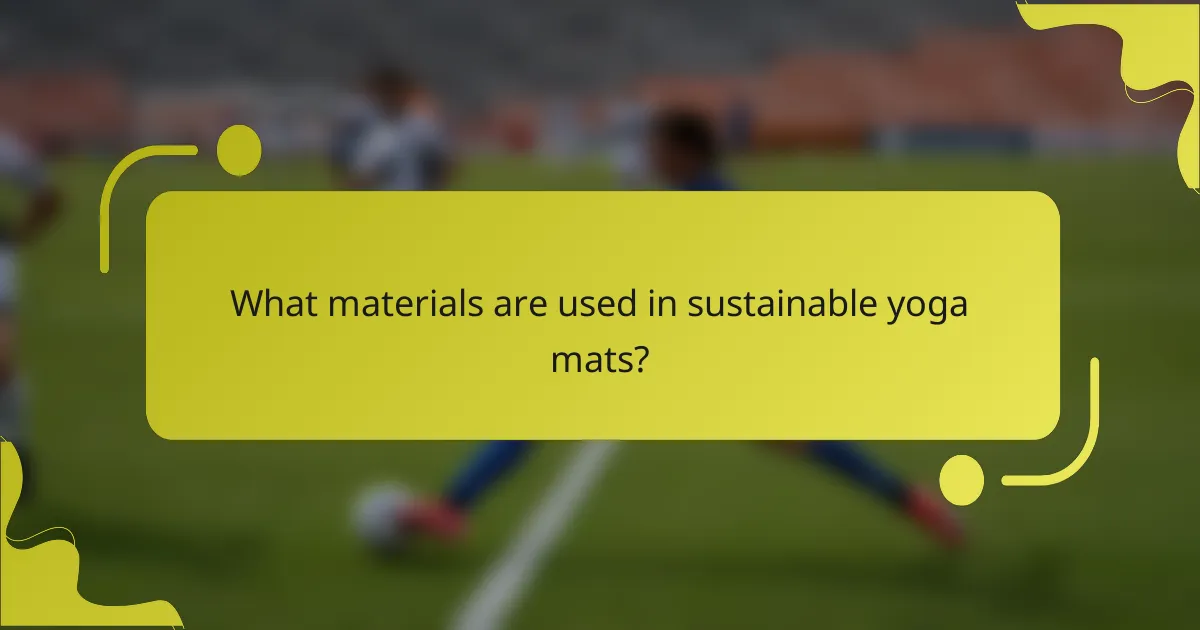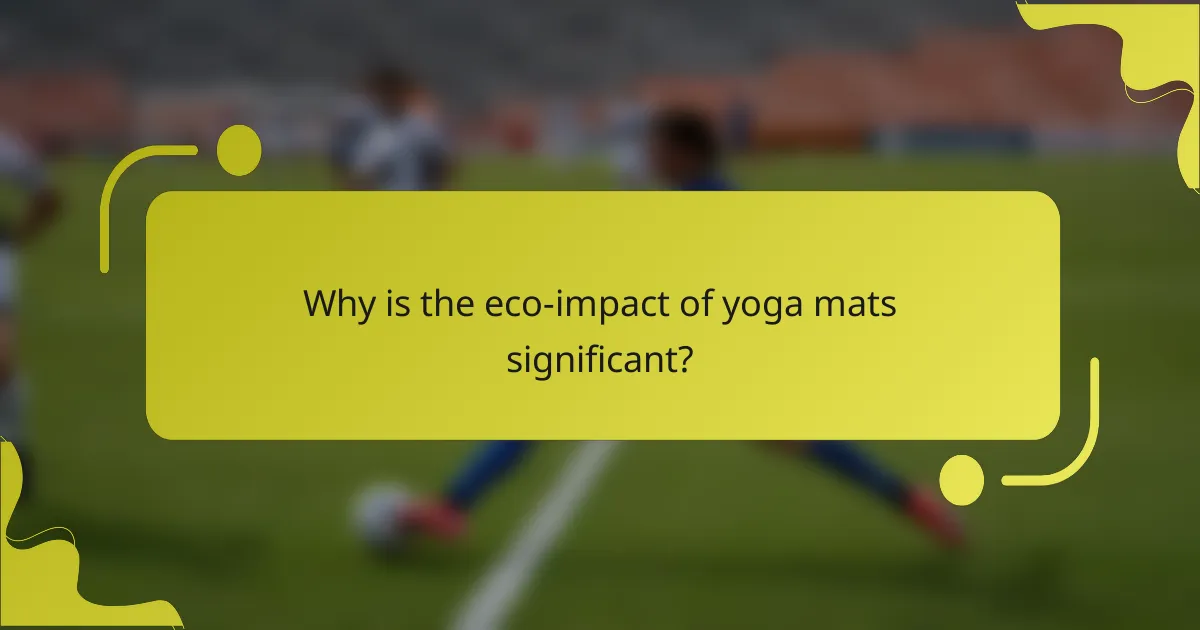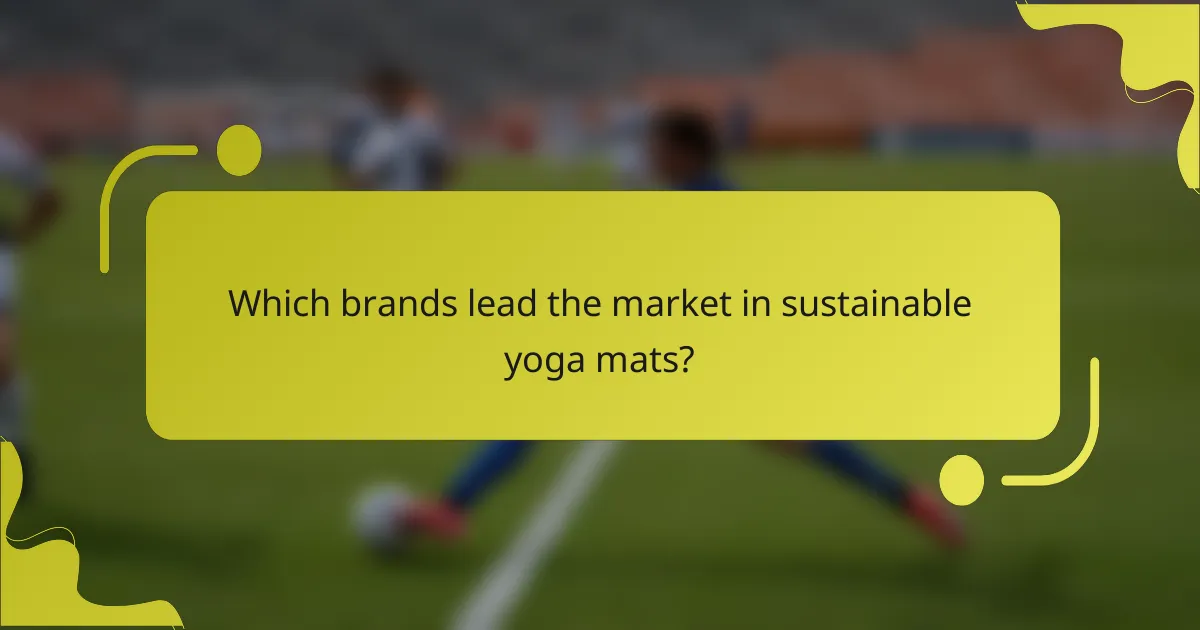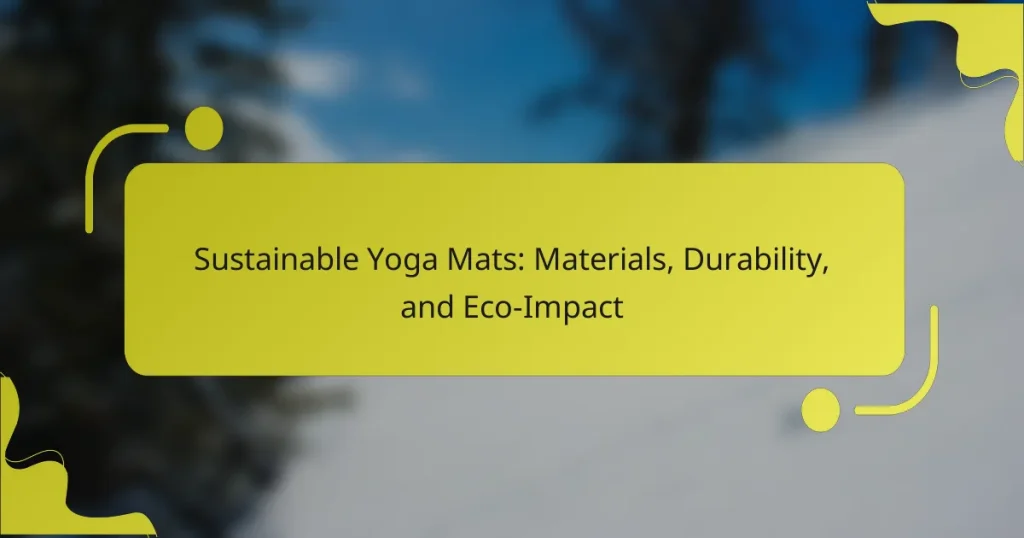Choosing a sustainable yoga mat can enhance your practice while supporting the environment. This article explores the eco-friendly materials used, the durability of these mats, and their overall eco-impact. Discover leading brands committed to sustainability and debunk common misconceptions. Learn how proper care can further extend the life of your mat.

What materials are used in sustainable yoga mats?
Sustainable yoga mats are typically made from materials like natural rubber, jute, cork, and TPE. These materials are chosen for their eco-friendly properties and durability. Natural rubber is biodegradable and provides excellent grip. Jute and cork are renewable resources, adding a unique texture. TPE is recyclable, offering a lightweight alternative. Each material contributes to reducing environmental impact while ensuring longevity and usability.
How do natural rubber mats compare to synthetic options?
Natural rubber mats offer superior grip and durability compared to synthetic options. Natural rubber is biodegradable and sourced sustainably, reducing environmental impact. In contrast, synthetic mats often contain petroleum-based materials, which can harm ecosystems. Natural rubber mats generally provide better cushioning and traction, enhancing performance during yoga practice. However, synthetic mats may be lighter and more affordable, appealing to budget-conscious consumers.
What are the benefits of using cork in yoga mats?
Cork in yoga mats offers several benefits, including sustainability, natural grip, and antimicrobial properties. Cork is a renewable resource, making it an eco-friendly choice. Its natural texture provides excellent traction, enhancing stability during practice. Additionally, cork’s antimicrobial nature helps reduce odors and mold growth, promoting a healthier mat experience. These attributes contribute to the overall durability and eco-impact of sustainable yoga mats.
Which eco-friendly materials are gaining popularity in 2025?
Natural rubber, cork, jute, and TPE are eco-friendly materials gaining popularity for sustainable yoga mats in 2025. These materials offer durability and minimal environmental impact.
Natural rubber is biodegradable and provides excellent grip. Cork mats are sustainable and antimicrobial, enhancing hygiene. Jute is a renewable resource, while TPE is non-toxic and recyclable, appealing to eco-conscious consumers.
These materials contribute to reducing plastic waste and promoting sustainable practices in the fitness industry. The shift towards these alternatives reflects a growing awareness of environmental issues among consumers.

How does the durability of sustainable yoga mats impact their value?
The durability of sustainable yoga mats significantly enhances their value. High-quality materials, such as natural rubber or jute, contribute to longer lifespan and performance. Durable mats reduce the need for frequent replacements, leading to cost savings over time. Additionally, their eco-friendly production methods align with consumer values, making them more desirable. This combination of longevity and sustainability elevates the overall worth of these mats in the market.
What factors contribute to the lifespan of a yoga mat?
The lifespan of a yoga mat depends on material quality, usage frequency, maintenance practices, and environmental conditions. High-quality, eco-friendly materials like natural rubber or jute enhance durability. Regular cleaning and proper storage prolong lifespan. Exposure to sunlight and moisture can degrade mats over time.
How do wear and tear differ among various materials?
Wear and tear among various materials differ significantly based on their composition and durability. Natural rubber mats exhibit excellent resilience, while PVC mats show higher wear over time. TPE mats balance eco-friendliness and durability, but may wear faster than rubber. Jute mats are sustainable but less durable, leading to quicker degradation. Each material’s longevity impacts its eco-impact, with more durable options reducing waste.
What are the signs of a durable yoga mat?
A durable yoga mat shows signs of high-quality materials, resistance to wear, and longevity. Look for mats made from natural rubber or recycled materials, as these often provide better durability. Additionally, check for thickness; mats that are thicker than 5mm typically offer more support and resilience. Other indicators include a textured surface for grip, which prevents slippage over time, and a warranty or guarantee from the manufacturer, suggesting confidence in the product’s lifespan.

Why is the eco-impact of yoga mats significant?
The eco-impact of yoga mats is significant due to their material sourcing, production processes, and end-of-life disposal. Sustainable yoga mats, made from natural or recycled materials, minimize environmental damage. For instance, mats made from natural rubber are biodegradable, while those from PVC contribute to pollution. The durability of sustainable mats also reduces waste, as they last longer than conventional options. As a result, choosing eco-friendly yoga mats supports a healthier planet and promotes sustainable practices in the yoga community.
How do manufacturing processes affect environmental sustainability?
Manufacturing processes significantly impact environmental sustainability by determining material choices and production methods. Sustainable yoga mats use eco-friendly materials like natural rubber and jute, which reduce carbon footprints. Durability is enhanced through responsible manufacturing, resulting in longer-lasting products that minimize waste. Additionally, eco-impact is assessed by evaluating the lifecycle of materials, including their biodegradability and recyclability, promoting a circular economy.
What is the carbon footprint of different yoga mat materials?
The carbon footprint of different yoga mat materials varies significantly. Natural rubber mats typically have a lower footprint due to sustainable sourcing, while PVC mats have a higher environmental impact due to fossil fuel production. TPE mats offer a moderate footprint, being recyclable and made from non-toxic materials.
| Material | Carbon Footprint | Durability | Eco-Impact |
|—————-|———————–|——————-|———————|
| Natural Rubber | Low | High | Sustainable sourcing |
| PVC | High | Moderate | High pollution |
| TPE | Moderate | Moderate | Recyclable |
| Jute | Low | Moderate | Biodegradable |
How do sustainable mats contribute to waste reduction?
Sustainable mats significantly contribute to waste reduction by using eco-friendly materials and promoting longevity. These mats often utilize natural, biodegradable substances like rubber or jute, which minimize environmental impact. Their durability extends lifespan, reducing the frequency of replacements. Additionally, many brands implement recycling programs, encouraging responsible disposal. This holistic approach fosters a culture of sustainability, aligning consumer habits with environmental stewardship.

Which brands lead the market in sustainable yoga mats?
Leading brands in sustainable yoga mats include Manduka, Liforme, Jade Yoga, and Gaiam. These brands utilize eco-friendly materials such as natural rubber and TPE, ensuring durability and minimal environmental impact. Manduka’s PRO mat, for instance, boasts a lifespan of over 10 years, while Liforme mats are made from biodegradable natural rubber. Jade Yoga plants a tree for every mat sold, enhancing their eco-commitment. Gaiam offers affordable options that are PVC-free, appealing to a broader audience. Each brand prioritises sustainability, making them top choices for eco-conscious consumers.
What unique features set these brands apart?
Sustainable yoga mats stand out due to their unique materials, durability, and eco-impact. Brands like Manduka use natural rubber, enhancing grip and longevity. Jade Yoga mats incorporate sustainable practices, using recycled materials and offering a unique tree-planting initiative. Gaiam emphasises non-toxic manufacturing processes, ensuring safety for users and the environment. Additionally, brands like prAna focus on fair trade practices, setting them apart in ethical production. Each brand’s commitment to sustainability creates distinctive value for eco-conscious consumers.
How do consumer reviews influence brand reputation?
Consumer reviews significantly shape brand reputation by influencing consumer perceptions and trust. Positive feedback enhances credibility, while negative reviews can deter potential buyers.
Sustainable yoga mats, made from eco-friendly materials like natural rubber and jute, often receive favourable reviews due to their durability and low environmental impact. Consumers value mats that not only perform well but also align with their values of sustainability.
Research indicates that brands with higher ratings tend to enjoy better market performance. For example, a study found that a one-star increase in ratings can lead to a 5-9% increase in sales.
In summary, consumer reviews act as a crucial feedback mechanism, impacting brand reputation and driving purchasing decisions in the sustainable product market.

What are common misconceptions about sustainable yoga mats?
Many believe sustainable yoga mats are always biodegradable, but this is not true for all materials. Common misconceptions include that all eco-friendly mats are made from natural rubber, that they lack durability compared to conventional mats, and that they are significantly more expensive. In reality, some sustainable mats are made from synthetic materials designed to minimise environmental impact while maintaining durability. Additionally, prices can vary, making sustainable options accessible. Understanding these misconceptions helps consumers make informed choices that align with their values.
Why do some believe eco-friendly mats are less effective?
Some believe eco-friendly mats are less effective due to misconceptions about material performance and durability. Traditional mats often use synthetic materials that provide better grip and cushioning. In contrast, sustainable mats made from natural materials may not offer the same level of traction or longevity. However, advancements in eco-friendly technologies have improved these mats significantly. Many now feature enhanced grip and durability, challenging the notion that they are inferior. As a result, the perception of effectiveness often stems from outdated comparisons rather than current innovations in sustainable yoga mat design.
How can misinformation impact purchasing decisions?
Misinformation can significantly mislead consumers, affecting their purchasing decisions regarding sustainable yoga mats. Incorrect claims about materials or eco-impact can lead to choices that do not align with environmental values. For instance, if a product is falsely advertised as biodegradable, consumers may unknowingly support non-sustainable options. This can undermine trust in brands and the overall market for eco-friendly products. As a result, accurate information is crucial for informed decision-making in purchases related to sustainability.

What are the best practices for caring for sustainable yoga mats?
To care for sustainable yoga mats, regularly clean them with gentle soap and water, avoid harsh chemicals, and store them in a cool, dry place. Proper maintenance extends their lifespan and enhances their eco-impact.
1. Clean with mild soap and water weekly to remove dirt and oils.
2. Air dry completely to prevent mold and odor.
3. Avoid direct sunlight to maintain material integrity.
4. Roll mats instead of folding to prevent creases.
5. Store in a breathable bag to protect from dust and moisture.
How can proper maintenance extend the life of a yoga mat?
Proper maintenance can significantly extend the life of a yoga mat by preventing wear and tear. Regular cleaning removes dirt and oils that can degrade materials, while proper storage avoids unnecessary bending or exposure to heat. Using eco-friendly cleaning solutions preserves the integrity of sustainable materials. Additionally, following manufacturer guidelines enhances durability, ensuring the mat remains functional and safe for longer.
What cleaning methods are recommended for different materials?
Sustainable yoga mats require specific cleaning methods depending on their materials. For natural rubber mats, use a mixture of warm water and mild soap, avoiding harsh chemicals. For PVC mats, a solution of vinegar and water effectively removes dirt and odors. TPE mats can be cleaned with a damp cloth and mild detergent. For jute mats, a vacuum or dry cloth is best to maintain texture and integrity. Always air dry mats to prevent mildew and extend their lifespan.
What common mistakes should users avoid with their mats?
Users should avoid common mistakes like choosing mats with harmful materials, neglecting proper care, and overlooking the mat’s durability. Selecting mats made from non-sustainable materials can harm the environment. Regular cleaning and maintenance extend the mat’s lifespan, while ignoring these practices can lead to wear and tear. Additionally, users should consider the mat’s thickness and texture, as these factors impact comfort and stability during practice.




